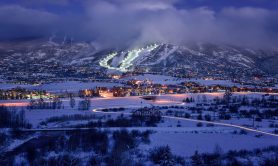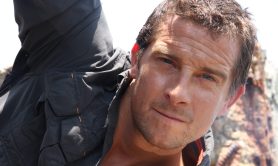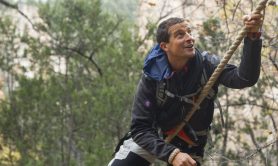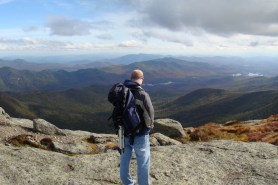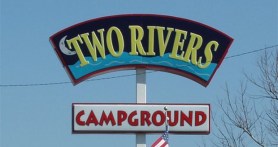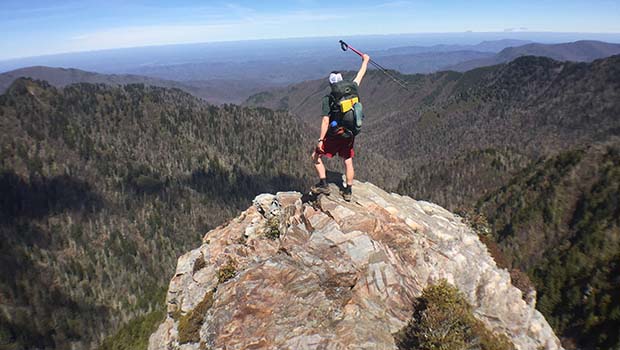

The challenges of thru-hiking the Appalachian Trail are many – both physical and mental. Then, think about setting out to do it on your own … in just four months! You’ve got to be darn tough!Owen Rachampbell was the right man for the job. Personally, he’s optimistic, adventure-seeking, adaptive, and mentally tough. Professionally, he’s the Dealer Service Rep for Darn Tough Socks. It turned out to be an unbeatable combination. 50 Campfires had the pleasure of Owen as a special guest on a recent Daily Outdoor Livestream on Facebook. He answered many questions about tackling the A.T., but there were so many more to ask. It seemed like a good idea to follow-up with this “On The Line” interview.
Videos by Outdoors with Bear Grylls
Owen Rachampbell hangs darn tough thru-hiking the Appalachian Trail in just four months!
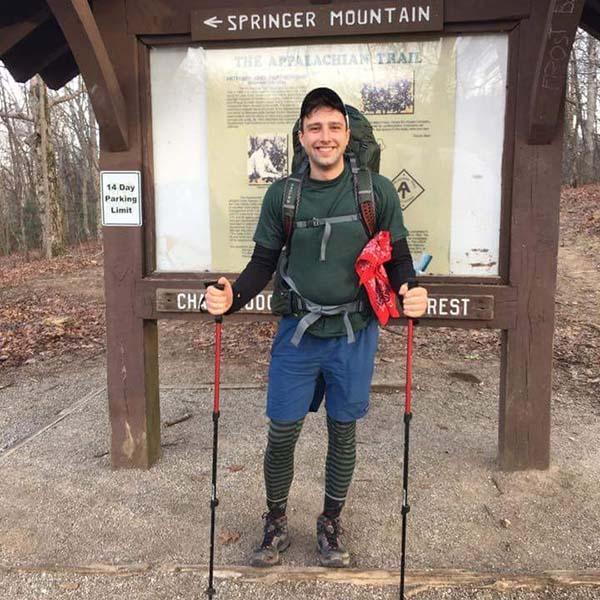
50 CAMPFIRES: Our first question is, “How did it come about that you set out to hike the Appalachian trail?”
OWEN: I knew I wanted to hike the AT when I hiked the Long Trail of Vermont in 2010 with my best friend Ben. The two trails overlap for about 100 miles from the Massachusetts/Vermont border heading north. We met some incredible people who were about 3/4 of the way into the AT and I knew from hearing their stories that the trail was where I belonged and the AT was something I had to do.
From that point on, there were no ifs: it was always “when I do the AT…” I started to save money right after college for the hike (gear and food along the way is quite an expense). However, life always got in the way of me actually doing it. When I came to work for Darn Tough, I quickly knew that I wanted to stay there for a long time, but the prospect of building a career meant the AT would, yet again, have to wait. I eventually expressed my aspirations to Darn Tough and they were very supportive of me taking a leave of absence to follow this dream.
50 CAMPFIRES: Did you take along music? Was there a “play list” for the trip? What was on it?
OWEN: Some folks listen to music constantly while hiking and some prefer not to listen to it at all. I would save music and especially podcasts as a very special treat, which was typically at the end of the day. There were fewer than 40 songs saved in my phone, and I know them really well now. I kept a good supply of podcasts in rotation when I could spare the battery and data to download them. Leaning toward comedy helped to keep my spirits up – favorites included My Brother, My Brother and Me, The Dollop, and The Adventure Zone.
50 CAMPFIRES: How did you get resupplied as you traveled?
OWEN: The AT weaves through some of the oldest parts of our country and there is no shortage of road crossings with hitch-hiking opportunities or actual towns you walk through. This was especially the case in the middle of the trail.
New England and the southernmost section take a bit more planning. The longest stretch without a town is in Maine – the 100 Mile Wilderness. Some hikers plan meals and drop-boxes ahead of time for the whole trail. They send them to post offices and other drop points along the way. I chose to shop for food the whole trip in order to stay more versatile and less tied to specific resupply locations and their hours. I also get bored of certain items (I will never eat another Clif Bar in my life!) and this allowed me to change it up.
The flip side to this was inconsistency. Not all towns had my ideal hiking foods, so improvisation sometimes became a fun game if I needed food to carry me to a better resupply point. For instance, I ate nothing but cheese, Fritos, and Pop-Tarts for 3 days once. Not ideal nutrition….

50 CAMPFIRES: Is thru hiking a solitary experience or do you meet a significant amount of people along the way? What’s the longest you went without seeing anyone? Where?
OWEN: When I first set out in Georgia, there were a ton of people. It stayed this way for a couple hundred miles and then thinned out as people found their paces and some people chose not to continue.
I like solitude, so I started the trail earlier than most to be ahead of “the bubble.” By Tennessee, I was more on my own, but would see people at established campsites. The longest I went without seeing anyone was 3 days in Virginia when a lot of people had hunkered down because of several days of rain. It can be hard to be alone, and I’ll be honest that it was lonely for me in those longer stretches.
This was one of my biggest challenges out there and I dealt with it by reminding myself of how lucky I was to be out there and of my goals. It’s common for people to find “trail families” – people they hike with for some or all of the trail – to help with this too. I hiked with people on and off, finding people with a similar pace here and there, but was doing my own thing most of the journey. Being alone allows for flexibility, and you ultimately move faster.
50 CAMPFIRES: How many pairs of shoes did you go through? What recommendations do you have?
OWEN: I went through six pairs of shoes total. Four of those were completely worn out and two I ditched prematurely due to them being too tight. It’s common for feet to grow and swell from all the walking. Mine were no exception with a whole-size change by about 400 miles in. (While they did shrink back down mostly after my hike, my feet are still wider EIGHT months later).
The “real” hiking boots I started out with were the Vasque Inhalers, which lasted the longest and were also ones I ditched early when they started to be too tight. After that I actually wore sneakers as they were light and cheap, but unfortunately not durable!. I was wearing running shoes for most of New Hampshire and Maine as that’s what fit best and was accessible
For gear in general, you kind of have to just do what works for you.
50 CAMPFIRES: As you hiked, did you camp every night (tent or A.T. shelters) or did you occasionally “stay in town” along the way?
OWEN: It can be really lonely to camp alone all the time. I would seek established sites to meet others as well as have less of an impact on the environment. It was a treat to stay in town here and there too! Hiking the AT is a great way to see the country and the small communities of the East Coast.
I would often camp to save money, but would “splurge” for a bunk in a hostel if I felt I earned it or if it made sense logistically. I stayed with many friends along the way too – my first being right near the Great Smoky Mountain National Park. These friends really made my journey a success. They gave me something to look forward to and graciously offered their homes and resources to fuel my adventure.
50 CAMPFIRES: We’ve heard that everyone who hikes the A.T. ends up with a trail nickname. What is yours and how did you get it?
OWEN: I got mine on The Long Trail in 2010. My best friend and I gave each other ironic tough-sounding trail names: he was McGruff and I was VanGrizzle.
These were not set in stone until Stratton Pond where we met Cyclops, thus called due to the constant eye-like headlamp on his noggin. Cyclops carried around a foam sword “for holding aloft on majestic peaks…and the occasional knighting.”
We kind of liked this whole knighting idea, so we set about performing good deeds to earn this honor. That night, a knighting ceremony was held, and I was knighted Sir Owen VanGrizzle Duke of Beartown. I henceforth went by VanGrizzle for short and carried this name over to the AT.
50 CAMPFIRES: What’s the most important advice you can offer someone who is considering or, at least dreaming of, thru hiking the A.T.?
OWEN: Plan as much as you can, but recognize that once you’re out there, you have to do what your body tells you and put your health first. Before the hike, read up on gear, meals, and systems and then TEST THEM OUT!
Take shorter overnight hikes leading up to the big one. Get used to the weight and see what works best for you. You don’t want to throw yourself out there with something you’re not familiar with. Once you’re out there, it’s important to be malleable and adapt as you need to what your body is telling you. Plans are good, but feeling stress to stick to them is not why you’re hiking.

50 CAMPFIRES: We’ve heard you say, “Hike your own hike?” What does that mean?
OWEN: There are a lot of people out there on the trail and everyone is out there for different reasons. Sometimes, unfortunately, some people can be know-it-alls or try to make things competitive. The response to that is “hike your own hike.” This is the nice way of saying, “mind your own business.”
The person who knows what is best for you is yourself and while criticism can be constructive, especially when it comes to safety, trail health, and sustainability, let people do their own thing as long as it is not having a negative impact on others or the trail itself.
50 CAMPFIRES: Having completed the A.T. in such a short time and working for a sock company, you undoubtedly have unique insight into the importance of “the right” socks for hiking. How important are socks? Tell us the model of Darn Tough Socks your hike inspired.
OWEN: Your feet take a beating out there, and you need to take care of them. You can have the best boots or shoes in the world, but they won’t perform the best unless you have good socks. Good socks offer cushioning for the feet and protection from the material of your shoes, prevent blisters and hot spots, wick moisture, discourage microbes, and offer climate control for your feet. I wore merino wool socks that offered all of these features; a Darn Tough standard – the Hiker Micro Crew Cushion (Model Number 1466).
About halfway through the trail, I developed shin splints and turned to compression socks to help. I saw a lot of other hikers using compression socks or sleeves and many swore by their benefits. Through my sock hookup, I was able to get a pair of Darn Tough running Over the Calf Graduated Light Compression socks, which, due to their super-thin ultra-light knit, I wore as liner socks under my 1466s. This combination alleviated my pain a bit and helped my circulation, and I wore them every day for the last 1,200 miles to the end of the trail in Maine.
When I got back, our product team was pretty excited by my use of the graduated light compression and I worked with them to develop a special hiking model that takes our best hiking socks and extends them to be over the calf with graduated light compression. I was pushing for them to be named after me, of course, but we settled on Trail Legs. Those will be out this summer and I am pleased as punch to have inspired a sock unlike any other on the market!
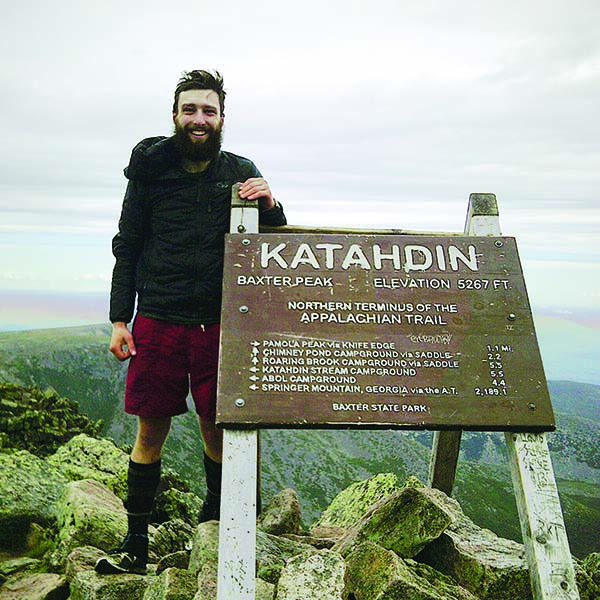
50 CAMPFIRES: Now that you completed the A.T., do you see it as the ultimate outdoor achievement of your life, or do you have plans, thoughts, dreams of even bigger things?
OWEN: Before my hike, this goal was to be my crowning achievement. Now that I’m off the trail, I miss it a lot. I feel at home out there and love the simplicity of life and the challenge of taking care of myself. I by no means want to diminish my accomplishment, but I would, and probably will, do it again. There are other amazing trails, both literally and figuratively, for me to walk.
50 CAMPFIRES: Can you offer advice to the camping family – who is probably NOT interested in thru hiking – about how and where they might be able to get a great taste of the A.T.? Do you know of great day hikes?
OWEN: There are SO many great spots through each of the 14 states the trail passes. To keep it simple, I’ll say that National Parks are great places to check out the trail and meet other hikers. The AT goes through The Great Smoky Mountain National Park as well as Shenandoah National Park. Both are very different parks and offer different experiences on the trail.
Visit the Appalachian Trail Conservancy website too to learn about different sections as well as educate yourself on Leave No Trace principles in order to steward the trail for future visitors. Everyone has a place on the trail special to them!



